Vehkalahti (Swedish : Veckelax) is a former municipality surrounding the town of Hamina in south-eastern Finland. At the beginning of 2003 Hamina and Vehkalahti combined to form a new town of Hamina.
Contents


Vehkalahti (Swedish : Veckelax) is a former municipality surrounding the town of Hamina in south-eastern Finland. At the beginning of 2003 Hamina and Vehkalahti combined to form a new town of Hamina.


These southern parts of Karelia are known to be the oldest parts of modern Finland with settlements. First markings of Vehkalahti as a continuous settlement or village are dated in 1336, when it has become a major place for east/west trading. The plans to build a town grew slowly as the place become crowded. In 1653 the area surrounding the village church officially became a town, which was called Vehkalahden Uusikaupunki (Swedish : Veckelax Nystad, English: Newtown of Vehkalahti). [1] [2]
While the area in the immediate vicinity of the church building became a town, the surrounding land remained countryside. Formerly the area of Vehkalahti was much larger, almost the entire Kymenlaakso, but later many areas became new municipalities. [3] Largest population centers are Husula, Salmenkylä, Uusi-Summa, Poitsila and Neuvoton, there are also many rural villages like Metsäkylä, Reitkalli, Kannusjärvi and Pyhältö.
In literature, Vehkalahti is particularly renowned for its peculiar medieval petty nobility, knaappiaateli (families Husgafvel, Pilhjerta and Brandstaka), which also acted as a link between Vehkalahti and the Vyborg Castle.[ citation needed ] Built by Swedes, about 100 kilometres (60 mi) east of Vehkalahti, it became place of great military importance for European east/west foreign communication. Today it is located on Russian territory.
The Vehkalahti church (now known as St. Mary's church, or Marian kirkko in Finnish) was built in the 14th century at the place where the town of Hamina is now.

Porvoo is a city and a municipality situated on the southern coast of Finland about 35 kilometres (22 mi) east of the city border of Helsinki and approximately 50 kilometres (30 mi) of the city centre. It is one of the six medieval towns in Finland, first mentioned as a city in texts from the 14th century. Porvoo is the seat of the Swedish-speaking Diocese of Borgå of the Evangelical Lutheran Church of Finland.

Kokkola is a town and municipality of Finland. The town is located in the Central Ostrobothnia region. The town has a population of 47,774 and covers an area of 2,730.80 square kilometres (1,054.37 sq mi) of which 1,286.61 km2 (496.76 sq mi) is water. The population density is 33.08 inhabitants per square kilometre (85.7/sq mi). Neighbour municipalities are Halsua, Kalajoki, Kannus, Kaustinen, Kronoby, Lestijärvi, Larsmo and Toholampi.

Falun Municipality is a municipality in Dalarna County in central Sweden. Its seat is located in the city of Falun. Falun is the second biggest city and provincial capital of Dalarna County. Falun was originally famous for its copper mine.
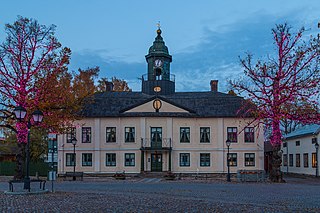
Hedemora Municipality is a municipality in Dalarna County in central Sweden. Its seat is in the city of Hedemora.
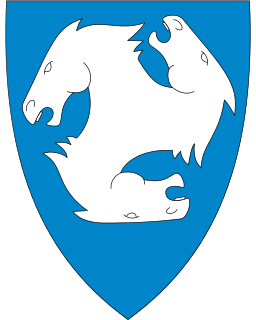
Ski is a town and former "kommune" (municipality) in the new municipality Nordre Follo in the greater region Follo, in Viken fylke (county), Norway.

Hamina is a town and a municipality of Finland. It is located approximately 145 km (90 mi) east of the country's capital Helsinki, in the Kymenlaakso region, and formerly the province of Southern Finland. The municipality's population is 19,890 and covers an area of 1,155.14 square kilometres (446.00 sq mi), of which 545.66 km2 (210.68 sq mi) is water. The population density is 32.63 inhabitants per square kilometre (84.5/sq mi). The population of the central town is approximately 10,000. Hamina is unilingually Finnish speaking.

Kirkkonummi is a municipality of 40,102 inhabitants in southern Finland. The literal meaning of the words "Kirkkonummi" and "Kyrkslätt" in English is "church heath".
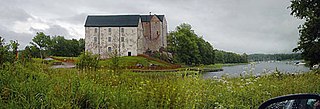
Sund is a municipality of Åland. It is an autonomous territory of Finland which is very rich in history and culture, being one of the official 27 National landscapes of Finland.
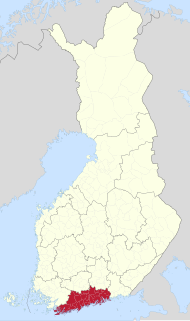
Uusimaa is a region of Finland. It borders the regions of Southwest Finland, Tavastia Proper (Kanta-Häme), Päijänne Tavastia (Päijät-Häme), and Kymenlaakso. Finland's capital and largest city, Helsinki, along with the surrounding Greater Helsinki area, are both contained in the region, and Uusimaa is Finland's most populous region. The population of Uusimaa is 1,638,469.
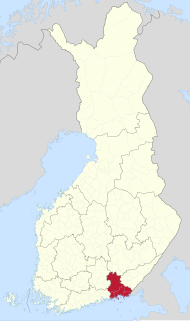
Kymenlaakso is a region in Finland. It borders the regions of Uusimaa, Päijät-Häme, South Savo and South Karelia and Russia. Its name means literally The Valley of River Kymi. Kymijoki is one of the biggest rivers in Finland with a drainage basin with 11% of the area of Finland. The city of Kotka with 51,000 inhabitants is located at the delta of River Kymi and has the most important import harbour in Finland. Other cities are Kouvola further in the inland which has after a municipal merger 81,000 inhabitants and the old bastion town Hamina.

Husula is a neighborhood in Hamina, Finland. It is located approximately 3 kilometres north from the town centre. Before the town of Hamina and municipality of Vehkalahti consolidated at the beginning of 2003, Husula was part of Vehkalahti. Together with the neighboring Salmenkylä, it comprises one of the biggest population centers in Hamina, with a population of nearly 2,000.

Keila is a town and an urban municipality in Harju County in north-western Estonia, 25 km southwest of Tallinn. Keila is also the location of administrative buildings of the surrounding Keila Parish, a rural municipality separate from the town itself.
The Finnish nobility was historically a privileged class in Finland, deriving from its period as part of Sweden and the Russian Empire. Noble families and their descendants are still a part of Finnish republican society, but except for the titles themselves, no longer retain any specific or granted privileges. A majority of Finnish nobles have traditionally been Swedish-speakers using their titles mostly in Swedish. The Finnish nobility today has some 6,000 male and female members.
Huusgavel, Huusgafvel, or Husgafvel, is listed as number 2102 on the List of Swedish noble families. The family originates from Veckelax Vehkalahti, Finland.
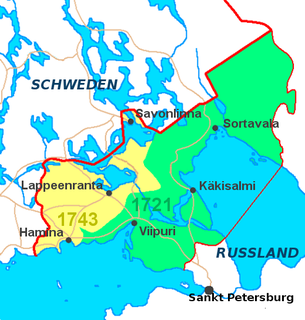
The attempt to create a Kingdom of Finland in 1742 is a little-known chapter in the history of Finland. Following the Russian occupation in the Russo-Swedish War (1741–1743) and vague promises of making the country independent, Finns elected the then Duke Peter of Holstein-Gottorp as the King of Finland. However, the political situation had outgrown the idea of Finnish independence and it quickly evaporated.
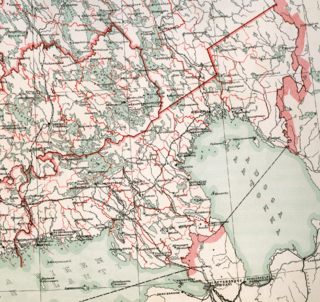
The Viipuri Province was a province of Finland from 1812 to 1945.

Hamina Fortress is located in Finland on the coast of the Gulf of Finland and it is an integral part of the Hamina city centre. Hamina fortress is a Star fort, representing the Renaissance ideal city embodied by Palmanova city in northeastern Italy.
A mantal is an obsolete unit once used in Finland and Sweden to measure the size and productivity of a piece of land. In the 1900s, the mantal lost its relevance because crown land taxes ceased to exist and the government started drawing revenue from income taxes.[citation needed] Today, mantal values are only used in connection with some rural obligations and rights, while the size of farms in Finland is reported in hectares.

Henrikki Laavunpoika of Kankainen, or Henrik Klasson Horn , was a Swedish military officer and Governor-General of Finland. He was an ancestor of the noble Swedish family, Horn af Kanckas.
Klaus Henrikinpoika, lord of Joensuu and Kankainen was in his time one of the most influential magnates in Finland. As keystone of his career, he received the justiciarship of Southern Finland which he held from 1487 to 1520. He was the first male member of his agnatic house to rise to great prominence in his country.
| Wikimedia Commons has media related to Vehkalahti . |
Coordinates: 60°34′32″N027°08′38″E / 60.57556°N 27.14389°E
| | This Southern Finland location article is a stub. You can help Wikipedia by expanding it. |